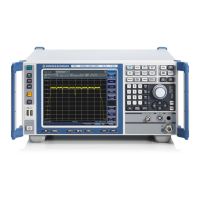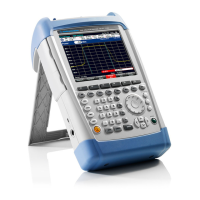Remote Control
R&S
®
FSVA/FSV
682Operating Manual 1176.7510.02 ─ 09
CALCulate<n>:MARKer<m>:FUNCtion:DEModulation[:STATe] <State>
This command turns the audio demodulator on and off when the measurement rea-
ches a marker position.
In the frequency domain, the hold time can be defined at the corresponding marker
position with CALCulate<n>:MARKer<m>:FUNCtion:DEModulation:HOLDoff.
In the time domain continuous demodulation is always on.
This command is only available if the R&S FSVA/FSV option B3 (Audio Demodulator)
is installed.
Suffix:
<n>
.
Selects the measurement window.
<m> Selects the marker.
Parameters:
<State> ON | OFF
*RST: OFF
Example:
CALC:MARK3:FUNC:DEM ON
Switches on the demodulation for marker 3.
Manual operation: See "Mkr Demod On/Off" on page 291
CALCulate<n>:MARKer<m>:FUNCtion:FPEaks[:IMMediate] <NoMaxima>
This command initiates a peak search.
The results can be queried with:
●
Position of a peak on the x-axis: CALCulate<n>:MARKer<m>:FUNCtion:
FPEaks:X
●
Position of a peak on the y-axis: CALCulate<n>:MARKer<m>:FUNCtion:
FPEaks:Y?
●
Number of peaks in the list: CALCulate<n>:MARKer<m>:FUNCtion:FPEaks:
COUNt?
The order the results are returned in is selected with CALCulate<n>:MARKer<m>:
FUNCtion:FPEaks:SORT.
The trace the peaks search is performed on is selected with CALCulate<n>:
MARKer<m>:TRACe.
Number of found maxima
The number of maxima found depends on the waveform and value set for the Peak
Excursion parameter (see CALCulate<n>:MARKer<m>:PEXCursion), however, a
maximum number of 200 maxima are determined. Only the signals which exceed their
surrounding values at least by the value indicated by the peak excursion parameter are
recognized as maxima. Therefore, the number of maxima found is not automatically
the same as the number of maxima desired.
Remote Control – Commands

